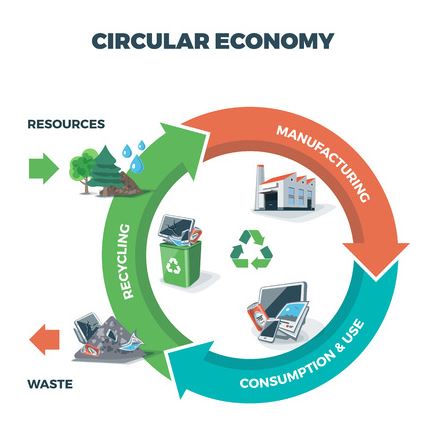 With more and more people on the planet, where are we going to put all of our garbage? In the future, will we keep creating and filling landfills? Ideally– no. Instead of just burying old, no longer needed items, the trend is toward recycling in what’s called a “circular” rather than “linear” model.
When you think of a line, it has a beginning and an end. A circle, however, doesn’t. For the longest time, people have mostly dealt with their waste in a linear fashion– we buy something, consume it, and throw it out. Where does it end up? Most likely, our “junk” ends up buried in the ground in a landfill somewhere. The current and future trend, though, is to sort out our waste in a way that makes sure as many things as possible can literally be recycled. Therefore, this circular approach means instead of filling the land with “junk,” we re-use it in feasible and new ways. Plastic bottles for water and soda are prime examples of how society can and does recycle. Rather than pile these bottles up in landfills, they get “melted down” (for lack of a better term) and their materials are reformed such that yesterday’s bottles become today’s bottles which then become tomorrow’s bottles.
In the years to come, look for more and more companies to join and develop what has been deemed the “reprocessing industry.” Essentially, this industry finds the valuable resources in what most people would consider trash, waste or junk. It then takes these resources and supplies manufacturers with them so they can continue to make new products for consumption.
Besides recycling and reprocessing items, the future trend for waste companies looks to be headed in the direction of turning waste into energy. Both thermal and biological technologies make this possible and profitable.
How we deal with our waste obviously depends on a number of factors. When businesses cooperate with governmental policies and mandates to reduce the amount of waste in the world, we all benefit.
]]>
With more and more people on the planet, where are we going to put all of our garbage? In the future, will we keep creating and filling landfills? Ideally– no. Instead of just burying old, no longer needed items, the trend is toward recycling in what’s called a “circular” rather than “linear” model.
When you think of a line, it has a beginning and an end. A circle, however, doesn’t. For the longest time, people have mostly dealt with their waste in a linear fashion– we buy something, consume it, and throw it out. Where does it end up? Most likely, our “junk” ends up buried in the ground in a landfill somewhere. The current and future trend, though, is to sort out our waste in a way that makes sure as many things as possible can literally be recycled. Therefore, this circular approach means instead of filling the land with “junk,” we re-use it in feasible and new ways. Plastic bottles for water and soda are prime examples of how society can and does recycle. Rather than pile these bottles up in landfills, they get “melted down” (for lack of a better term) and their materials are reformed such that yesterday’s bottles become today’s bottles which then become tomorrow’s bottles.
In the years to come, look for more and more companies to join and develop what has been deemed the “reprocessing industry.” Essentially, this industry finds the valuable resources in what most people would consider trash, waste or junk. It then takes these resources and supplies manufacturers with them so they can continue to make new products for consumption.
Besides recycling and reprocessing items, the future trend for waste companies looks to be headed in the direction of turning waste into energy. Both thermal and biological technologies make this possible and profitable.
How we deal with our waste obviously depends on a number of factors. When businesses cooperate with governmental policies and mandates to reduce the amount of waste in the world, we all benefit.
]]>

Recent Comments